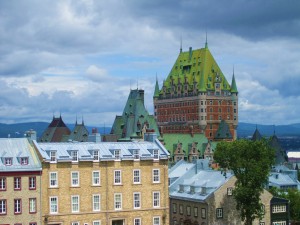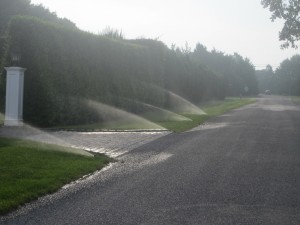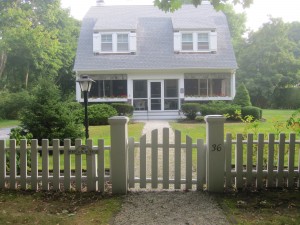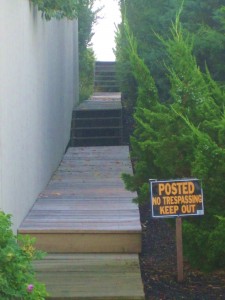The Hamptons: What’s Hot, What’s Not
I’ve just recently returned from visiting The Enlightened Land, i.e. Canada, specifically, Quebec City, and perhaps that has colored my American view; a view long-accustomed to isolating a few injustices to rant about rather than looking at the vast canvas of injustice against which we fling our careless paint. In Canada, unlike in the United States, it seems that the default setting is an interest in the welfare of an entire community. It is an interest that leads to strong and continuous investment in the public good, including well-maintained parks, recreational walk-ways that take in – rather than block – the view, beautification of public buildings and a sweet pride in a collective history that gives equal place to those Native people that were disenfranchised. While the city is predominantly white – as are most of her tourists – there is very little attempt made to white wash the past.
Sure, not everybody is able to pay $416 and up to stay at the Chateau Frontenac, but the rentable flat  around the corner from the Frontenac affords an equally splendid view. And the music that floats from the mouths of street musicians assaults or delights every ear in equal measure no matter the thread count on the sheets upon which he or she may lay at night. The Cirque du Soleil performs free of charge for people of every stripe and the acts, spread as they are around the outdoor viewing area, ensures that the view remains the same for everybody.
around the corner from the Frontenac affords an equally splendid view. And the music that floats from the mouths of street musicians assaults or delights every ear in equal measure no matter the thread count on the sheets upon which he or she may lay at night. The Cirque du Soleil performs free of charge for people of every stripe and the acts, spread as they are around the outdoor viewing area, ensures that the view remains the same for everybody.
Which brings me to America and, specifically, to The Hamptons where I was on holiday with good friends. The Hamptons was a place I had heard referred to in architecture magazines lying around the waiting rooms of doctors and dentists. I knew that it was a place that the New York City rich “fled” to during the summer months. But being a foreigner who still calls Maine home simply because Box 523 Bates College, Lewiston, ME 04901 was listed as my permanent mailing address for over a decade, and whose Maine experiences as an adult involve long stretches of coast line undamaged by human vanity, The Hamptons in the flesh served to displease. Apparently, there is a way to “do the Hamptons right” and it involves being a publishing heiress, a three-home owning Polo star (Argentina, Palm Beach and the Hamptons), a cook with her own TV show etc. etc. Those grains of sand, those drops of water, those blades of grass? They don’t feel quite the same to the rest of us.
As a way of assuaging a little of the outrage I feel, and taking a leaf from what appears to be a Hamptons tradition, I have come up with a list of what’s hot and what’s not here in the Hamptons.
Hot: Homes that can be maintained by the home-owner.
Not Hot: Homes manicured by armies of underpaid migrant workers who bend their heads and step off into the hedges when people walk by.
Hot: Not caring what Hamptonians think is hot when mixing and matching swimwear for the beach
Not Hot: Following anybody else’s idea of fashion other than your own (and, just for the record, I think all these supposedly “hot” bachelors look like asinine clones!)
Hot: Greeting everybody when using running paths and biking trails.
Not Hot: Glaring at customers and assessing their net worth before deciding not to serve them.
Hot: Eschewing identical and towering hedges and tree hydrengeas in favor of gardening with original flair that happens to include vegetables.
Not Hot: Sprinkler systems that have no rain-sensors

Hot: Disguising pool fences with greenery.
Not Hot: Two tennis courts per mansion for every mansion in a ten-mansion block.
Hot: Letting a vacation house accumulate its furnishings through generations of occupancy.
Not Hot: Designing multi-million dollar four season homes which remain empty seven months of the year.
Hot: Lying on the beach when exhausted by being pummeled by the surf.
Not Hot: Lying on the beach to acquire a tan while reading trashy paperbacks.
Hot: Teenaged guards in white polo shirts who look away and do not ask for “beach access ID tags.” Also, deer who don’t give a doe’s behind for signs put up by human beings.
Not Hot: Narrow access-ways to the beach blocked by Private/No Trespassing/Keep Out signs.

Hot: Journal editors who, finding themselves in enclaves of exclusivity, treat it as an anthropological exercise with the potential for comic relief.
Not Hot: Magazines that celebrate exclusivity as though it were a serious virtue.
Okay, so that’s the heart of it, really, that exclusivity. It grates. And I believe the reason for its existence is a staggering lack of shame on the part of many Americans. To live comfortably in a country ruled by laws that champion the individual at the cost of the community must, surely, necessitate an absence of conscience. It is what makes it possible for a town in the Hamptons to put up an access-way, post sentries at cost, and charge those who do not own a home here, $7 per person to frolic in the waves. The waves themselves remain unowned, and the beach below the high water mark is ostensibly public. But if you prevent people from reaching that no-man’s land, then what is in effect is a violation of the right of access to public land.
As I sat on the beach – the only brown person for miles around – a little boy drew a line in the sand around me and muttered something to the effect that I could stay there and that’s it. I am here in the Hamptons with parents whose kids would never consider quarantining strangers in their own pre-marked zone of exclusion. They would find that both puzzling and shame-worthy. I wonder when the balance is going to shift toward that second model of parenting. I doubt the movement is going to start here in the Hamptons.





P and c both asked the question ‘mom did ru leave the box’?
Say it, sister.
Dear, lovely well-brought up super-smart girls, P&C – Of course I left the box! “NOBODY puts baby in the corner…” and this baby doesn’t need a guy to get her out of it either! you’ll have to ask your mom where that comes from – Big hugs, ru.
I’d forgotten how flawless the Canadians were, and in particular how they show that all of the United States’ social and political problems could be solved if not for the existence of unenlightened and evil people. The Canadians are clearly better at taking care of people: that’s why their unemployment rate has been so much lower. Oh, wait, it hasn’t; a graph from 1990 to the present turns out to look virtually identical, and Canada’s *average* since 1976 has been 8 percent, compared to the U.S.’ 5.7 since 1948; the Canadians are currently back down to 8 compared to the U.S.’ 9.6, but that’s something more like a return to the norm. Of course, the Canadians might have a more accurate reporting system, so their numbers might more closely reflect reality than the U.S. numbers do. But even if so, that gives very little reason to talk about the Canadians as more ‘enlightened’ than the U.S. when it comes to economic policy.
About 4% of Canadians over the age of 15 are alcoholics. So are about 4% of people in the U.S. over the age of 15. But we thought their attitudes to alcohol were more European, and so more civilized, and so less problematic. Hmmm.
Half of Canadian women over the age of 16 have been assaulted, sexually or otherwise. One to two women per week are murdered by a current or former domestic partner.
While Canada has a significantly lower murder rate than the U.S., somehow or other the U.S. rate has been declining more rapidly since 1991 than it has in Canada, and some Canadian cities (e.g., Regina) would, if parts of the U.S., rank among the top ten most violent.
As for the wonderful harmony between the aboriginal peoples and the rest of Canada, you might note that even though aboriginal peoples make up only about 3.5% of the population, they account for more than 20% of the prison population. The problems that aboriginal people face with poverty, disease, and substance abuse are also well known. Of course, it’s nice that Canadians tend to care, even officially, about these problems and that they recognize the history of those peoples. But you might have noticed that the unenlightened rednecks that you disdain in the U.S. are often absolutely insane when it comes to Native American culture, and that being able to say you’re ‘part Indian’ is a serious point of pride. And if you think the U.S. whitewashes its history, then you certainly didn’t go to any sort of school like I did, where we learned in gruesome detail from about 3rd grade on about terrible things done to Native Americans. It also seems impossible to account for the almost cult status of otherwise dreadfully boring movies like Dances with Wolves without recognizing a significant interest among (at least certain sub-cultural groups of) Americans in Native American culture and an accompanying awareness of how those people were mistreated.
So, in short, I’m not trying to play your ‘U.S. vs. Canada’ game so much as to bring you back to reality and help you see how pointless it is to play in the first place. Canada is not a utopia where everybody does more than their required part to contribute to the common good and everybody loves one another. They, like most of us, have problems that they don’t know how to deal with, some of which can’t be blamed on anybody’s being unenlightened or having the wrong political ideology. I’m with you on admiring Canada a great deal; but you’ll do yourself a favor if you don’t pretend that being better than another country in some respects makes a place great.
On the other hand, I heartily approve of your disparagement of the Hamptons.